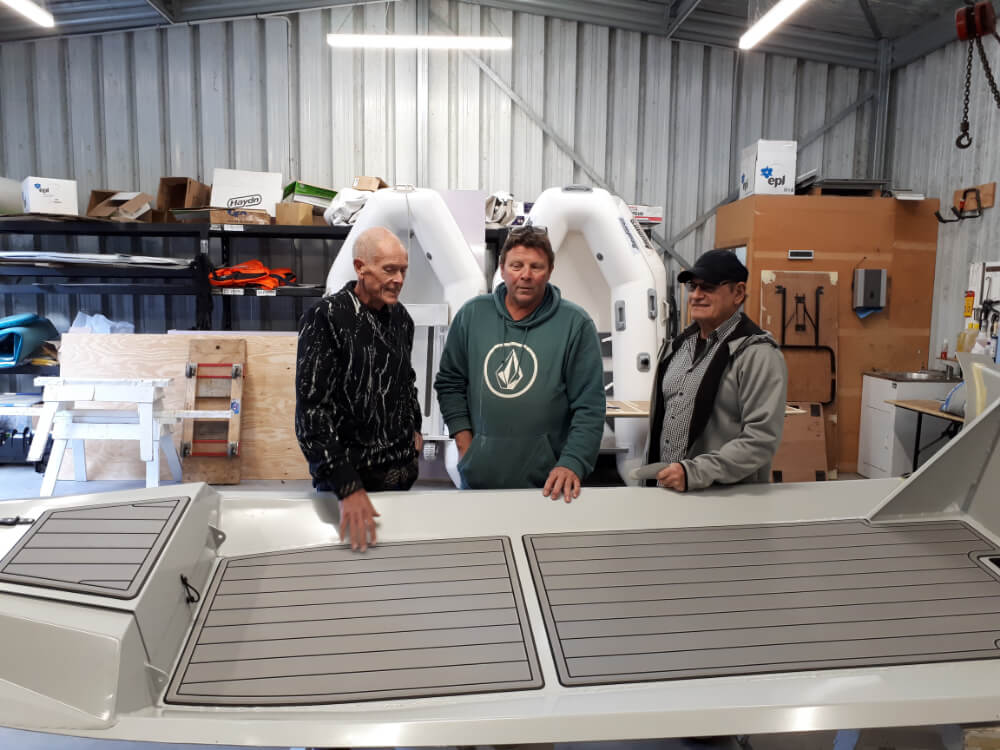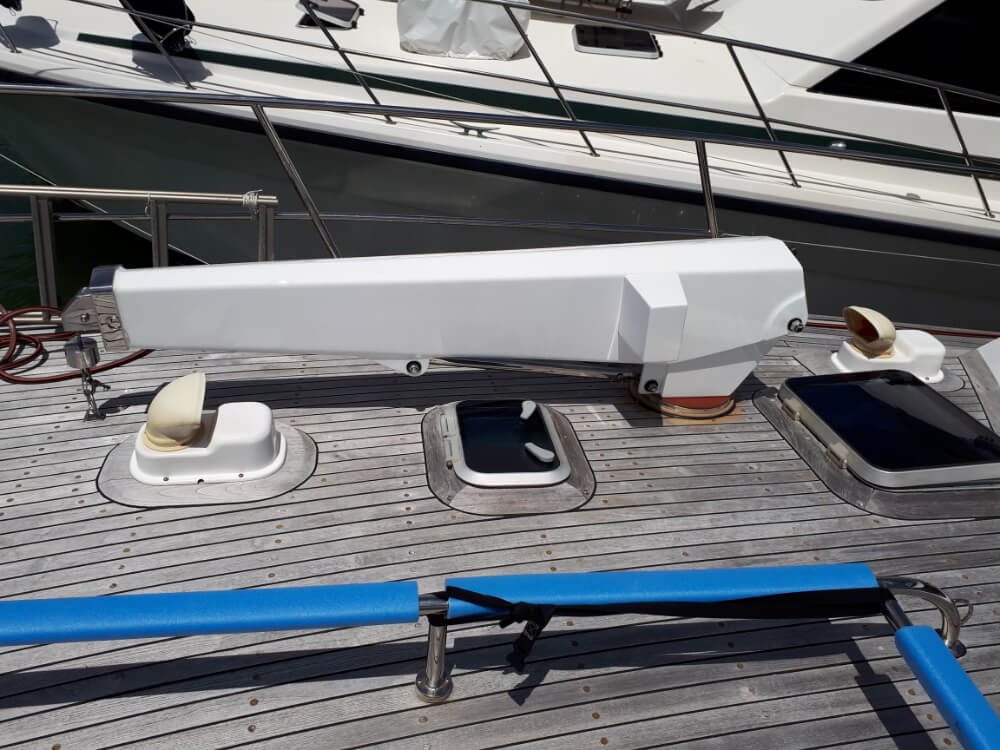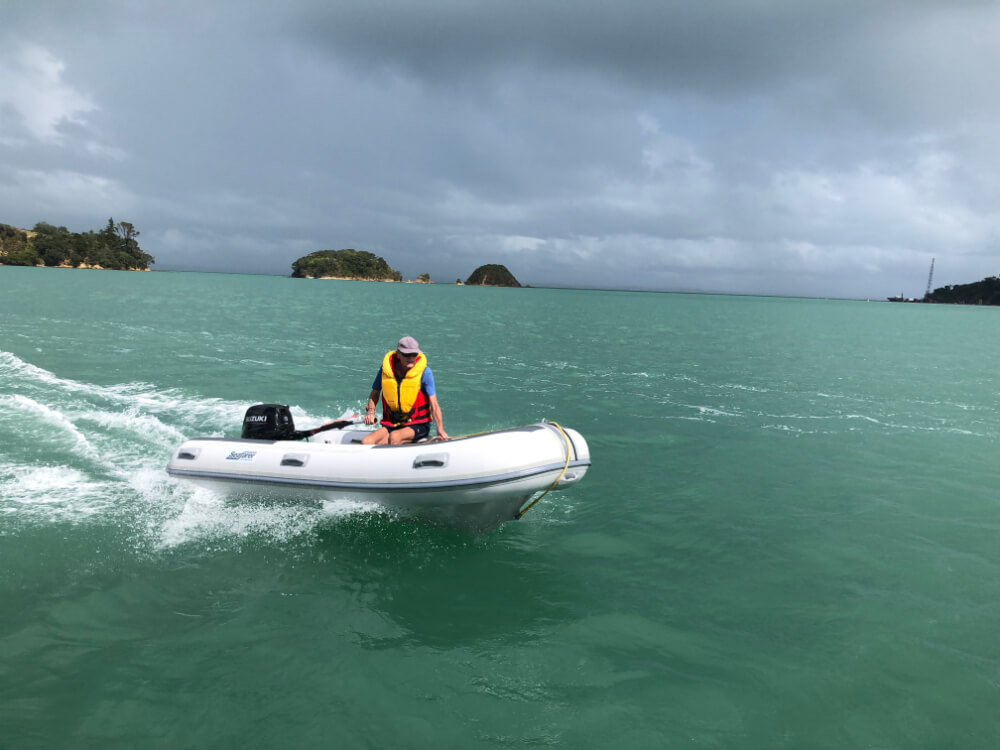Laurie Cranfield reports on updating his Salthouse 16m, Rapport with a new ADC deck crane, and Seafarer RIB.
We’ve enjoyed our 16 metre Salthouse SportFisher, Rapport, for well over two years now and after more than 200 nights aboard find her a capable and comfortable cruising vessel. But when you buy pre-owned you inevitably make some compromises and in our case there were three; flexible plastic flybridge clears rather than glass, all electric galley rather than lpg and an inadequate dinghy. We decided to live with the first two, but we really enjoy exploring areas in proximity to our anchorages and ideally wanted a 3 metre rigid-hulled inflatable boat (RHIB) with a 15hp 4-stroke outboard, lifted aboard by a crane.
Rapport came without a crane and with an old locally branded but Chinese-made inflatable that we literally rubbished after a few weeks as it had so many air leaks. It was December and we urgently needed a tender that two of us could easily lift onto our foredeck cradle, so bought a new lightweight (33kg) Aquapro SLR 2.6m rigid-hulled inflatable and Honda 2.5hp 4-stroke air cooled outboard. We’d used the same outboard during our Med cruising years and found it to be very reliable and easy to lift and start. But for Rapport this was always a temporary solution and so aided by our best friend and long time boating companion, Frank, we started researching deck cranes and larger inflatables.
We knew this was going to be an expensive project and that making improvements to a boat doesn’t necessarily add value. A trusted marine broker’s thoughts were that future potential buyers of Rapport would expect a vessel of this size to carry a substantial RHIB and crane, so adding these would improve her saleability and value. We didn’t need too much convincing and reassured by his advice and the prospect of lots more fun ahead decided to proceed.
Breaking the project down into four pieces we researched deck crane, RHIB, outboard and ancillary gear.

Finding a suitable crane
The RHIB with its outboard, fuel and gear will weigh about 150kg so we need a 24V DC powered crane with a safe working load of at least that. We find plenty of options for large cranes but few for smaller units.
Australia’s Davco is a popular brand but its delivery time was quoted in excess of six months at that time.
Motor Yacht Service Centre (MYSC) are the New Zealand agent for Brisbane-based Australian Davits and Cranes (ADC) and we find them very helpful having fitted many ADCs with good results. MYSC’s owner Dean Ryder checks Rapport and quotes $13,973 plus installation for their 350kg capacity crane mounted on our starboard side with its standpipe passing down through our master berth’s wardrobe thus minimising interior disruption.
Oceanlift cranes are produced on a bespoke basis in Rotorua and we find owner Mark Thomson also provides lots of information, quoting $13,711 plus installation for his 200kg capacity crane.
Both units will suit us however the ADC’s additional capacity will provide an extra safety margin, more future flexibility and enhanced resale value. These factors combined with the fact that MYSC install their ADC cranes whereas we need a separate contractor to instal the Oceanlift lead us to choose ADC. We expect the installation to take around three days and to cost around $6-8,000.
Which RHIB will suit us best?
We’re looking for a rugged rigid-hulled RHIB about 3 metres in length with room for four adults, able to plane with at least two adults aboard using a 15hp outboard, with generous beam for lateral stability, a snub bow rather than a pointed bow for greater internal space forward, a false flat deck for easier internal movement and to keep contents dry, a high bow to deflect spray, robust pontoons with three separate air compartments, paddles rather than oars and rowlocks, internal lifting points, rubbing strakes, self-draining bung, storage for anchor and accessories and handles on the pontoons and bow. We’ll also fit top-of-the-line Beachmaster pneumatic wheels and two rod holders. We have a preference for a powder coated alloy hull (being lighter and easier to repair), but will accept GRP all other things being equal.
We eliminate centre console options as in our view they take up too much room in a 3 metre RHIB and add too much weight, complexity and expense.
I’ve had good experiences with Aquapro and Frank has with Quicksilver, so we make a short list including these plus Southern Pacific and Zodiac. Initially we weren’t aware of AB and Seafarer brands and later add these to our list. All sellers we speak to are able to provide a complete package including outboard and are willing to negotiate a deal.
Ruggedness largely relates to selection of pontoon material and the current four mainstream offerings are plasticised polyvinyl chloride (“PVC or vinyl”), blends of pvc with thermoplastic polyurethane (TPU), blends of polychloroprene (“Neoprene”) with chlorosulphonated polyethylene (“Hypalon”) and lastly straight TPU.
In each case these materials are used to coat a polyester or polyamide (“nylon”) fabric substrate. Although there’s lots of debate about the pros and cons of each material due to different product qualities and variations in design, manufacture and quality control, the above list represents an ascending order of technical excellence. Also we’re aware of two successful New Zealand brands that encountered major problems after they switched production to China, eventually reverting to New Zealand manufacture, so won’t consider Chinese options.
Historically the Neoprene/Hypalon blend was considered the gold standard, but opinion has largely turned towards TPU taking that spot. In fact the US Navy conducted a study of pontoons in 2001 concluding “tubes constructed of TPU exhibit better key physical properties than tubes constructed of Hypalon … better tensile strength, tearing strength, puncture resistance and abrasion resistance.” It also has superior air retention, chemical (ie fuel) resistance and seams can be welded whereas Hypalon can only be glued.
Despite the above Frank and I have both experienced good results previously with pvc pontoons and their life can be maximised by using a storage cover and fitting chaps to provide the pontoons with extra ultra-violet, abrasion and puncture resistance.
We’d been inclined towards Zodiac, their brand being synonymous with RHIBs, but they only offered us RHIBs built in Indonesia with GRP hulls and pvc pontoons while availability appeared to be an issue. Of the imported brands we’re most impressed by AB, produced in Belgium with an alloy hull and using a Neoprene/Hypalon blend for tubes. However wanting a few custom features added we visit local producer Seafarer Inflatables, based in Dairyflat north of Auckland where we’re immediately impressed by owner Neil Curtling’s enthusiasm and willingness to share his extensive knowledge based on 35 years in the industry. Seafarer use a unique hot air welding process and their product incorporates all of the features we’re looking for and more, such as Ultralon’s U-Dek decking providing a great cosmetic appearance, grip and underfoot feel. They also produce for another well-known brand as well as repairing all types of inflatables and can produce pontoons using either a PVC/TPU blend, Hypalon or TPU. We’re also impressed by their 10 year warranty. After discussions with Neil we decide to go a little larger than 3 metres and buy their SF340R, 3.4 metres long with a generous beam of 1.8 metres. Although we would have been happy with pontoons made from PVC/TPU we decide to go with the top of the line TPU, largely because this offers ultimate durability and in a worst case scenario our RHIB is our life boat. TPU costs an additional $755 bringing the price to $6,992. Neil’s attention to detail continued to impress, for example suggesting that he pre-drill the mounting holes for wheels and rod holders in the alloy hull prior to its powder coating to minimise future corrosion.

Bring on the power
We put Honda, Mercury, Suzuki, and Yamaha on our list of 15hp 4-stroke outboard power options. Over the years I’ve favoured Yamaha, but have also happily owned Honda and Suzuki while Frank has a lot of experience with Mercury and Suzuki. We’re happy that any of these engines will meet our basic needs and focus our attention on points of difference.
While some dealers were very helpful we’re frustrated getting brochures and information from others. Outboard manufacturers print expensive, comprehensive glossy brochures and spend a fortune on advertising. They may be horrified to learn some of their dealers don’t have brochures available for serious buyers and in most cases make no effort to inform us about product features. Sure, most of the information is on the web but have you tried printing it? If I’m going to spend around $5,000 on a product I want a nice glossy brochure.
We finally get our brochures and start our analysis.
Dealer prices offered range from $4,895 for the Suzuki to $5,339 for the Honda, but we’re buying on features not price. Several dealers cite supply issues, but in reality all options are available, even if not immediately.
We build our spread sheet noting that each brand has some unique features and becoming increasingly impressed with Suzuki:
-It’s several kilograms lighter than all other options and we feel this weight saving is significant placed aft of the RHIB’s transom where it counts (Suzuki advertise as being “lightest in class”).
-We prefer electronic fuel injection (EFI). Some dealers say this is a disadvantage citing reliability, but EFI was first introduced in 1987 (by Mercury) and that’s long enough to be well proven.
-It has a unique Lean Burn Control System offering increased fuel economy (Suzuki claim an incredible 45 per cent).
-We like the non-start fresh water flushing system (which Yamaha also has).
With Suzuki also offering the lowest price we decide on this option.
Adding accessories
Chandlers supply storage covers in various sizes and these are essential for protection against harmful ultra violet rays and the elements.
Frank used his Quicksilver for expeditions and carried all his equipment aboard. Our Seafarer will primarily be used as a tender, so we’ll only carry basic equipment of life jackets, tiller extension, anchor, chain and warp, length of line for towing or other emergencies, orange safety square, bailer, sponge, telescopic boathook marked for depths, knife, basic tool kit and spare kill switch. Secondarily we’ll use it for expeditions when we’ll carry additional safety and other gear depending on each situation. We’ll also carry aboard Rapport a spare propeller (of a different pitch) and sea water pump impeller.
Total cost of accessories including Beachmaster wheels is $900.

Installation
We place our orders by 20 July expecting crane installation and delivery of the Seafarer and outboard by end October. Melbourne was already under covid lock down and New Zealand follows in August leaving us wondering when we might see our crane. The Seafarer RHIB is ready by mid October but its outboard hasn’t arrived. The crane arrives early December and MYSC complete a very tidy installation a few days later. Fortunately we have a spare Mercury 4-stroke 6hp outboard to use initially.
Sea Trial
We find the crane simple to use and the RHIB is very stable and even with the 6hp outboard performs well, easily planing with one person and achieving a near plane with two. It tows well and stays very dry too with heaps of internal space. The Suzuki finally arrives mid-January and MYSC kindly swap the engines over for us. Now the real fun begins and we can easily plane with four adults aboard and tow the grand kids on their toys. We’ve been using the crane and RHIB for five months now and it’s met all our needs including providing the extra fun we wanted.
If you’re embarking on a project like this give plenty of thought to the dinghy’s intended use. A 3.4 metre model with a 15hp outboard is a bit too big and heavy for use just as a tender that you want to be able to pull up above the high water mark. However it’s ideal for us as our combination tender, water taxi, expedition craft and life raft.




